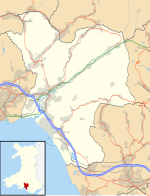|
Margam Stones Museum
Margam Stones Museum is a small Victorian schoolhouse near Port Talbot, South Wales, which now provides a home for one of the most important collections of Celtic stone crosses in Britain. All originally found within the locality of Margam, and mostly assembled as a collection in the 19th century, they provide enduring testimony to a Welsh Christian culture between the 6th and 16th centuries. The striking Cross of Conbelin is the most celebrated example. From around 1000 AD, it is a huge disc cross with Celtic interlace and plaitwork patterns, figurative scenes including a hunting scene, and inscriptions telling us who made it and who erected it. There are 17 early Christian stones, plus 11 memorials and other stones from the post-Norman periods. The museum is run by Cadw, the Welsh historic sites agency, and is close to Margam Abbey Church and the ruins of the Abbey buildings. AccessPostcode: SA13 2TA. Access road is just north of J38 of the M4, 4 miles (6.4 km) south-east of Port Talbot. There is a car park for visitors to the Abbey, Museum and Abbots Kitchen Restaurant. History of the museumMargam Abbey was a Cistercian Abbey founded in 1147, and the nave survives as Margam Parish Church. Upon its dissolution in 1536 the Mansel family acquired it, and built a mansion in the grounds. In 1786 it passed by marriage to the Talbot family of Lacock, Wiltshire, and it is they, during the 19th century, who began to gather together various stone crosses and standing stones in the locality. Initially they were placed in the mansion grounds. In 1892 Emily Talbot gave them to the nation, in the care of the Commissioner of Public Works. In 1932 they were moved into their present building, a former Church schoolhouse close to Margam Abbey Church. Other stones from the Abbey and the local area were added to the collection, which is now in the care of Cadw.[1] The Stones
2km 1.2miles
Eglwys Nunydd cross 8
7: Railway Station cross
Ilci and Ilquici 6
5: Abbey Church
and Chapter House
Pillar of Thomas 4
Bodvoc Stone 3
Pumpeius Stone 2
Stones Museum 1 Source locations for the Margam Stones (where known). 1 Margam Stones Museum2 Pumpeius Stone (Kenfig)3 Bodvoc Stone4 Cwrt Uchaf (4, Pillar of Thomas; also 9 and 16)5 Margam Church and churchyard (5,6,7, 8 and 15)6 Cwrt-y-defaid (10, 11: Ilci and Ilquici crosses)7 Port Talbot Railway Station (cross 12)8 Eglwys Nunydd (Cart wheel cross 13)Of the 30 or so ancient carved stones in the museum, 17 are pre-Norman, and are displayed on the ground floor. The remainder are Margam Abbey memorials, housed in the upper gallery, and are mainly tomb slabs. They include Cistercian and post-reformation memorials. The pre-Norman stones form a distinct local group of early Christian carvings and inscribed text, and are described as one of the most important such collections in Britain.[1] Ten of these stones originate from Margam and its outlying settlements. Four others came from the area that became the Port Talbot steelworks, and three are from the hills and farms of the wider area.[1] The stones in the museum are part of a much larger group of carved and inscribed stones found across Glamorgan dating to the early Christian centuries. They can be classified into three groupings:[1]
Latin inscribed memorialsNo. 1. Roman Milepost and post-Roman memorialThe milestone dates to 309–313, the dates for Emperor Maximinus. It was turned upside-down and re-used in the 6th century, when a memorial to Cantusus was inscribed. It is a sandstone pillar, 1.52 metres (5.0 ft) high, and 0.48 metres (1.6 ft) by 0.25 metres (0.82 ft), first noted in 1839.[2]
 No. 2. Stone of Pumpeius CarantoriusThis stone is also known as the Pumpeius Stone,[3] the Kenfig Stone, and by local tradition 'Bêdh Morgan Morganwg' (The sepulchre of Prince Morgan).[4] It was first recorded in 1578. A squared pillar of Old Red Sandstone, 1.35 metres (4.4 ft) tall, it contains both Latin and Ogham scripts. Two areas of Ogham script appear, written as notches along the side of the stone, on the same face as the Latin name.[5]
 No. 3. Bodvoc StoneA stone pillar also known as 'The Margam Stone', and 'Carreg Lythyrenog'. It originates from a nearby mountain location, set into a prehistoric burial mound, where a replica now stands. It was first documented in 1578, and local folk-lore declared that anyone reading the inscription would die soon afterwards.[6] It is a stone pillar, 1.01 metres (3.3 ft) high, with four lines of Latin inscription and an incised cross. On the back there is an Ordnance Survey bench mark, and various more recent carvings. It was moved to the museum before 1945.[6]
Cross inscribed slabs These date from 600 to 900 AD and are crudely produced compared to the later sculptured crosses. Several of the Margam stones feature these incised carvings, including No 3, and the back of No 13. Only No 4 falls purely within this category. No. 4. Pillar of ThomasA tall cylindrical stone pillar with the top broken and missing. Three outline Latin crosses are cut in, and a short inscription. The pillar is 1.14 metres (3.7 ft) high, with a diameter of 0.38 metres (1.2 ft), tapering slightly towards the base. It was discovered 'under a hedge' at Cwrt Uchaf Farm in 1857, before being moved to join the Margam collection.[9]
Sculptured crosses and cross slabsThese date from 900 to 1100 AD, and form the great majority of the Margam early Christian collection. Seven of them are from the immediate environs of Margam, and three are from the same location as the Pillar of Thomas, implying perhaps two pre-Norman monastic establishments in the area, using the local sandstone to create distinctive Celtic stone sculpture.  No. 5. Cross of EinionThe earliest of the Glamorgan disc-headed crosses (along with one at Llantwit Major). The cross and stem have intricate lattice patterns with an inscription in insular majuscule script.[1] First mention of this cross was in 1873, by which time it was in the Abbey Chapter house collection. It measures 1.88 metres (6.2 ft)high, 0.96 metres (3.1 ft) wide and 0.13 metres (0.43 ft) thick, made from locally occurring Pennant sandstone.[10] The circular head of the cross has been roughly cut back to make it a more even shape for re-use as building material.
 No. 6. Cross of GrutneA disc-headed sculptured cross, with an inscription which fills the cross stem. First mentioned in 1697, it was in Margam Abbey Churchyard, south of the Church, until it was moved into the museum.[11] It is 1.01 metres (3.3 ft)high, 0.48 metres (1.6 ft) wide and 0.3 metres (0.98 ft) thick, made from locally occurring Pennant sandstone.[11] The cross head is 0.44 metres (1.4 ft) in diameter. It is made from a single piece of Pennant sandstone, although a thin tenon on its base suggests it was made to fit into a pedestal socket.[11] Stylistically the splayed arms and wide circular armpits are similar to 10th-century crosses from the north of England.[11] Date: 10th century
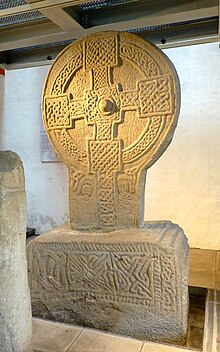 No. 7. Cross of ConbelinThe largest of the Margam Stones, and with the most decorative and figurative carvings, the RCAHMW describe it as "the most impressive of the monuments of this category in the county, if not in all Wales".[12] It has an immense stone wheel-cross with knot-work arcs, plaitwork cross, and a central boss. The shaft includes carved figures flanking the cross, taken to be St John holding his gospel, and the virgin Mary. This is set into a massive stone pedestal block with intricate geometrical patterns and a hunting scene which would originally have formed the front, but was at some point reversed, so is now at the back of the pedestal. Both parts are made from Pennant sandstone and it has been known traditionally as 'The Sanctuary Stone'.[13][14]
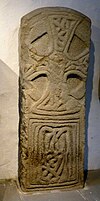 No. 8. Disc-headed slab crossThe sides of this cross have been trimmed back, probably to use for building material. The cross and stem have decorative interlace panels.
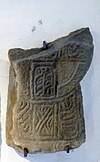 No. 9. Disc-headed slab crossThis cross head has suffered considerable damage, such that less than half of the circular head of the cross remains. It has a crude interlace pattern
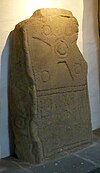 No.10. Cart-wheel CrossSo-called 'pannelled cart-wheel cross' with an illegible inscription.
 No. 11. Cross of IlciCart-wheel Cross, found along with No 12 being used as a footbridge, which has caused severe abraiding of both the carvings and the inscriptions. First noted in 1693, it is smaller but otherwise very similar to No 12, the cross of Ilquici, and shares its subsequent history. It stands 1.65 metres (5.4 ft) above ground, 0.79 metres (2.6 ft) wide and 0.25 metres (0.82 ft) thick, made from locally occurring Pennant sandstone.[17]
 No. 12. Cross of IlquiciCart-wheel Cross, found along with No 11 being used as a footbridge. It was first noted in 1693, was moved to the Margam Abbey Chapter house ruins during the 19th century, and moved again into the museum building in 1932. It stands 1.93 metres (6.3 ft) above ground, 0.93 metres (3.1 ft) wide and 0.25 metres (0.82 ft) thick, made from locally occurring Pennant sandstone.[18]
No. 13. Cart-wheel CrossA stone slab showing a six-spoked 'cart-wheel' on the front and a linear 'ring cross' on the reverse. Although most linear crosses are dated rather earlier than the sculptured crosses, these are most likely to have been made at the same time.[1]
 No. 14. Carreg FedyddiolThis translates as 'The stone of Baptism' as it was wrongly thought to be a font. What was thought to be a central bowl is now identified as a pedestal with socket to hold a now absent cross. It has interlace pattern and moulded edging 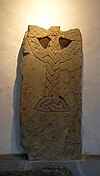 No. 15. Crux Christi plaitwork cross slabPart of a slab, the top of the cross, is missing. The holes through the cross arms may not originally have gone all the way through.
 No. 16. Crux Christi plaitwork cross slabPart of a slab, possibly made to lie flat over a grave.
 No. 17. Grave MarkerSmall grave marker
Post-Norman stones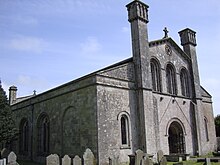  In 1147 the Margam monastery was re-founded as a Cistercian Abbey by Robert, 1st Earl of Gloucester and lord of Glamorgan. With French monks, an English lord and new Abbey buildings, there would have been little or no interest in the earlier monastery, and the early stones are the main evidence that survives. The Nave and west front of the Cistercian Abbey Church, on the other hand, survived both the reformation and a 19th-century renovation, and is now the Parish Church. The remainder of the Abbey buildings, including the Chapter house, with its memorials to the Cistercian Abbots, became part of the estate of the Mansel and then Talbot families, and are now part of Margam public park. The Talbot family collected the early Christian Stones in and around the Chapter house, and under the care of the Commissioner of Public Works they were all re-housed in the current museum, including five grave-slabs and an effigy from the pre-reformation period, and four post-reformation memorial slabs. Following Cadws major reworking of the museum building in the 1990s these later stones are all housed in the upper gallery, creating a clear distinction between the early Christian stones and the Cistercian and later memorials.[1] 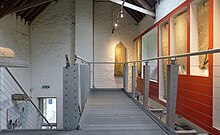 Most of the grave slabs give simple initials, but three that have names are to Robert, Abbot of Rievaulx (No. 21, 1307); Henry, the 9th Abbot (No. 23, 14th century) and a partial inscription in Welsh '...EV GORWEDD GORPH ELI[ZABETH] .. HON V GLADDWYD ...' ( [here] lies the body of Elizabeth ... who was buried...', (No. 25, c. 1600).[1] See also
References
External linksWikimedia Commons has media related to Margam Stones Museum. |
||||||||||||||||||

